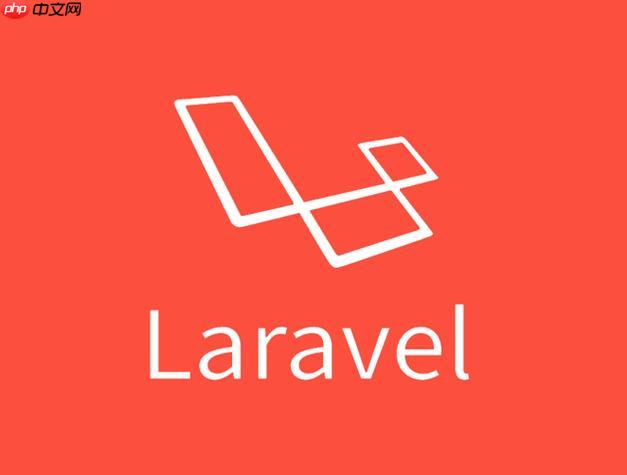Laravel文件系统扩展通过Flysystem库实现,支持配置现有驱动、引入第三方适配器或创建自定义适配器,从而灵活对接多种存储后端。1. 可在config/filesystems.php中配置不同磁盘,如本地备份目录或S3兼容服务Wasabi;2. 通过Composer安装第三方适配器(如SFTP),并在配置中添加对应驱动;3. 自定义适配器需实现Flysystem的FilesystemAdapter接口,并通过Storage::extend注册,实现无缝集成。常见场景包括多存储需求、遗留系统对接、多租户隔离、开发环境模拟及性能优化。挑战涉及兼容性、性能、错误处理、安全与维护,最佳实践包括优先使用社区方案、外部化配置、充分测试、日志记录、异步处理和缓存策略,确保扩展的稳定与可维护性。

Laravel的文件系统扩展,说到底,就是围绕着它底层所依赖的Flysystem库做文章。你可以通过配置已有的存储驱动,引入社区贡献的第三方适配器,甚至自己动手编写Flysystem适配器,来让Laravel的文件操作能力超越本地磁盘和S3的范畴,去拥抱更广阔的存储世界。这不仅仅是技术上的实现,更是一种根据项目实际需求进行架构决策的体现。
解决方案
Laravel的文件系统扩展,核心在于其强大的抽象层和可插拔的设计。以下是几种主要的实现方式,它们各有侧重,但目标都是让文件存储更灵活。
首先,最常见也最直接的方式是配置现有的存储驱动。Laravel开箱即用支持
local
public
s3
config/filesystems.php
disk
// config/filesystems.php
'disks' => [
// ... 其他默认配置
'backups' => [
'driver' => 'local',
'root' => storage_path('app/backups'),
],
'wasabi' => [ // 假设你使用Wasabi作为S3兼容存储
'driver' => 's3',
'key' => env('WASABI_ACCESS_KEY_ID'),
'secret' => env('WASABI_SECRET_ACCESS_KEY'),
'region' => env('WASABI_DEFAULT_REGION'),
'bucket' => env('WASABI_BUCKET'),
'endpoint' => env('WASABI_ENDPOINT'), // 这是关键,指向Wasabi的服务地址
'url' => env('WASABI_URL'),
'visibility' => 'public',
],
],接着,当你面对一些Laravel或Flysystem默认不支持的存储类型时,就需要引入第三方Flysystem适配器。Flysystem社区非常活跃,很多存储服务都有对应的适配器,比如FTP、SFTP、WebDAV、Azure Blob Storage等。以SFTP为例:
通过Composer安装对应的Flysystem适配器,例如
league/flysystem-sftp-v3
composer require league/flysystem-sftp-v3
在你的
config/filesystems.php
sftp
// config/filesystems.php
'disks' => [
// ...
'sftp' => [
'driver' => 'sftp',
'host' => env('SFTP_HOST'),
'port' => env('SFTP_PORT', 22),
'username' => env('SFTP_USERNAME'),
'password' => env('SFTP_PASSWORD'),
// 'privateKey' => env('SFTP_PRIVATE_KEY_PATH'), // 或者使用密钥
'root' => env('SFTP_ROOT', '/'),
'timeout' => 30,
],
],最后,也是最灵活但最复杂的方式,是创建自定义的Flysystem适配器。如果现有的适配器无法满足你的需求,或者你需要与一个非常特殊的、内部的存储系统对接,那么你就需要自己编写一个适配器。这通常涉及:
创建一个类,实现
League\Flysystem\AdapterInterface
FilesystemAdapter
write
read
delete
listContents
在你的服务提供者(通常是
AppServiceProvider
boot
Storage::extend
use Illuminate\Support\Facades\Storage;
use League\Flysystem\Filesystem;
use App\Filesystem\MyCustomAdapter; // 你的自定义适配器
public function boot()
{
Storage::extend('mycustomdriver', function ($app, $config) {
// 这里可以从$config获取你的自定义配置
$adapter = new MyCustomAdapter($config['api_key'], $config['base_url']);
return new Filesystem($adapter); // Flysystem 3.x
// return new \League\Flysystem\Filesystem($adapter, $config); // Flysystem 1.x
});
}同样,在
config/filesystems.php
mycustomdriver
通过这些方式,Laravel的
Storage

好买卖商城开源商城 是基于Opencart网店系统,针对中文用户而改进的本地化分支,是真正的开源PHP中文网店系统,兼容Opencart的插件。该系统具有易于操作的可视化安装界面、完善的前台商品展示和户在线购物车功能、强大的后台管理和维护功能模块简单易用,灵活的插件机制,更易于扩展。另外,好买卖商城开源商城 还集成集成了支付宝等支付和物流插件,更适合中文用户使用。 好买卖商城2.0开源商城流程进行
 0
0

在实际项目开发中,文件系统扩展的需求其实远比我们想象的要多。它不仅仅是换个地方存文件那么简单,更多时候是业务逻辑、成本控制和系统架构的综合考量。我个人遇到的几种典型场景包括:
mouf/flysystem-memory-adapter
这些场景都指向一个核心:文件存储不再是单一的选择,而是需要根据文件的生命周期、访问模式、安全性要求和成本预算,进行精细化管理。
将自定义的Flysystem适配器集成到Laravel的
Storage
Storage
核心思想是利用
Storage::extend()
以下是具体的步骤和一些思考:
编写你的自定义Flysystem适配器类: 这是基础。你需要创建一个PHP类,它必须实现
League\Flysystem\FilesystemAdapter
write
read
delete
listContents
fileExists
// app/Filesystem/MyCustomAdapter.php
namespace App\Filesystem;
use League\Flysystem\FilesystemAdapter;
use League\Flysystem\PathPrefixer;
use League\Flysystem\StorageAttributes;
use League\Flysystem\FileAttributes;
use League\Flysystem\DirectoryAttributes;
use League\Flysystem\UnableToRetrieveMetadata;
use League\Flysystem\UnableToReadFile;
use League\Flysystem\UnableToWriteFile;
use League\Flysystem\UnableToDeleteFile;
use League\Flysystem\UnableToCreateDirectory;
use League\Flysystem\UnableToSetVisibility;
use League\Flysystem\Visibility;
use Generator;
class MyCustomAdapter implements FilesystemAdapter
{
private string $apiKey;
private string $baseUrl;
private PathPrefixer $prefixer; // 用于处理路径前缀
public function __construct(string $apiKey, string $baseUrl, string $prefix = '')
{
$this->apiKey = $apiKey;
$this->baseUrl = $baseUrl;
$this->prefixer = new PathPrefixer($prefix);
}
public function fileExists(string $path): bool
{
$prefixedPath = $this->prefixer->prefixPath($path);
// 这里调用你的存储系统的API来检查文件是否存在
// 假设有一个API客户端 $this->apiClient->fileExists($prefixedPath);
return true; // 示例
}
public function write(string $path, string $contents, array $config): void
{
$prefixedPath = $this->prefixer->prefixPath($path);
// 调用API写入文件
// 假设 $this->apiClient->upload($prefixedPath, $contents);
if (false) { // 模拟失败
throw UnableToWriteFile::atLocation($path);
}
}
public function writeStream(string $path, $contents, array $config): void
{
// 类似write,但处理流
}
public function read(string $path): string
{
$prefixedPath = $this->prefixer->prefixPath($path);
// 调用API读取文件内容
// return $this->apiClient->download($prefixedPath);
return 'file content'; // 示例
}
public function readStream(string $path)
{
// 类似read,但返回流资源
}
public function delete(string $path): void
{
$prefixedPath = $this->prefixer->prefixPath($path);
// 调用API删除文件
// $this->apiClient->delete($prefixedPath);
if (false) { // 模拟失败
throw UnableToDeleteFile::atLocation($path);
}
}
public function deleteDirectory(string $path): void
{
$prefixedPath = $this->prefixer->prefixPath($path);
// 调用API删除目录
}
public function createDirectory(string $path, array $config): void
{
$prefixedPath = $this->prefixer->prefixPath($path);
// 调用API创建目录
}
public function setVisibility(string $path, string $visibility): void
{
$prefixedPath = $this->prefixer->prefixPath($path);
// 调用API设置文件可见性
}
public function visibility(string $path): FileAttributes
{
// 调用API获取文件可见性
return new FileAttributes($path, null, Visibility::PUBLIC);
}
public function mimeType(string $path): FileAttributes
{
// 调用API获取文件MIME类型
return new FileAttributes($path, null, null, null, 'text/plain');
}
public function lastModified(string $path): FileAttributes
{
// 调用API获取文件最后修改时间
return new FileAttributes($path, null, null, time());
}
public function fileSize(string $path): FileAttributes
{
// 调用API获取文件大小
return new FileAttributes($path, null, null, null, null, 1024);
}
public function listContents(string $path, bool $deep): Generator
{
$prefixedPath = $this->prefixer->prefixPath($path);
// 调用API列出目录内容
yield new FileAttributes('some_file.txt');
yield new DirectoryAttributes('some_directory');
}
public function move(string $source, string $destination, array $config): void
{
// 实现移动逻辑
}
public function copy(string $source, string $destination, array $config): void
{
// 实现复制逻辑
}
}创建或修改服务提供者: 通常,你会在
AppServiceProvider
boot
AppServiceProvider
FilesystemServiceProvider
// app/Providers/FilesystemServiceProvider.php
namespace App\Providers;
use Illuminate\Support\Facades\Storage;
use Illuminate\Support\ServiceProvider;
use League\Flysystem\Filesystem; // Flysystem v3
use App\Filesystem\MyCustomAdapter;
class FilesystemServiceProvider extends ServiceProvider
{
public function boot()
{
Storage::extend('mycustomdriver', function ($app, $config) {
// $config 参数会包含你在 filesystems.php 中为该 disk 定义的所有配置
$adapter = new MyCustomAdapter(
$config['api_key'],
$config['base_url'],
$config['prefix'] ?? ''
);
return new Filesystem($adapter, $config); // 第二个参数传递配置给Flysystem
});
}
}注册服务提供者: 如果创建了新的服务提供者,别忘了在
config/app.php
providers
// config/app.php
'providers' => [
// ...
App\Providers\FilesystemServiceProvider::class,
],配置你的自定义驱动: 在
config/filesystems.php
disk
mycustomdriver
// config/filesystems.php
'disks' => [
// ...
'my_remote_storage' => [
'driver' => 'mycustomdriver',
'api_key' => env('MY_CUSTOM_STORAGE_API_KEY'),
'base_url' => env('MY_CUSTOM_STORAGE_BASE_URL'),
'prefix' => 'app_data/', // 可选,为所有路径添加前缀
],
],完成这些步骤后,你就可以像操作其他任何Laravel存储驱动一样,使用
Storage::disk('my_remote_storage')->put('path/to/file.txt', 'Hello World');扩展Laravel的文件系统,虽然带来了巨大的灵活性,但同时也引入了一些需要仔细考量的挑战。我的经验是,任何脱离现有成熟方案的“自定义”,都意味着更高的维护成本和潜在风险。因此,在决定走这条路之前,深思熟虑并遵循一些最佳实践至关重要。
潜在的挑战:
最佳实践:
FilesystemAdapter
UnableTo...
config/filesystems.php
.env
Storage
Log
Visibility
总之,扩展文件系统是一个强大的
以上就是Laravel文件扩展?文件系统如何扩展?的详细内容,更多请关注php中文网其它相关文章!

每个人都需要一台速度更快、更稳定的 PC。随着时间的推移,垃圾文件、旧注册表数据和不必要的后台进程会占用资源并降低性能。幸运的是,许多工具可以让 Windows 保持平稳运行。

Copyright 2014-2025 https://www.php.cn/ All Rights Reserved | php.cn | 湘ICP备2023035733号